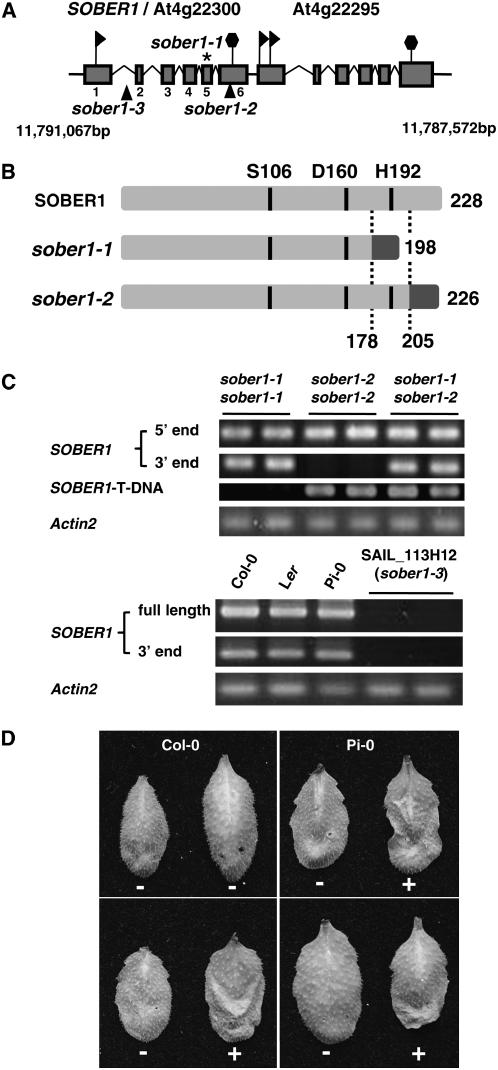Figure 6.
Mutations in SOBER1 Confer Resistance to AvrBsT in Arabidopsis.
(A) Scheme of the genomic locus for SOBER1/At4g22300 and At4g22295. Exons are represented with shaded boxes and introns with broken lines. The asterisk denotes the Pi-0 sober1-1 mutation in exon 6, and the triangles denote the T-DNA insertion in Col-0 sober1-2 (SALK_036632) and Col-0 sober1-3 (SAIL_113H12) lines. Flags and hexagons indicate coding sequence start and stop codons, respectively. Chromosome IV coordinates are designated in base pairs.
(B) Scheme of the predicted peptides encoded by the SOBER1, sober1-1, and sober1-2 alleles. The conserved catalytic residues (Ser [S], Asp [D], and His [H]) in the predicted Ser hydrolase are indicated. Domains in light gray are identical to wild-type SOBER1. Domains in dark gray are unrelated to SOBER1.
(C) SOBER1 mRNA expression in sober1-1, sober1-2, and sober1-3 plants. The 5′ end (327 bp of exon 1) and 3′ end (309 bp of exon 6) of SOBER1 mRNA were amplified by RT-PCR using total RNA extracted from unchallenged leaves from Pi-0 sober1-1, Col-0 sober1-2, and F2 individuals from a Pi-0 × SALK_036632 cross (sober1-1 sober1-2). The SOBER1 T-DNA chimeric cDNA fragment (377 bp) was amplified with an exon 4 primer and a T-DNA left border primer. In all cases, the PCR products matched the expected cDNA fragment size. To analyze sober1-3 lines, the full-length (802 bp) and 3′ end of SOBER1 mRNA were amplified by RT-PCR using total RNA extracted from unchallenged leaves from Col-0, Ler, Pi-0, and two sober1-3 homozygous individuals (SAIL_113H12 line). All PCR products were sequenced. Actin2 (At3g18780) was used as a reference control.
(D) HR phenotype of F1 individuals from a Pi-0 × SALK_036632 cross (sober1-1 sober1-2). In each panel, the right and left leaves were infiltrated with a 3 × 108 cfu/mL suspension of Pst DC3000 pVSP61 and Pst DC3000 pVSP61(avrRpt21-100-avrBsT11-350-HA), respectively. + = HR and − = no visible response at 10 to 12 h after inoculation.

